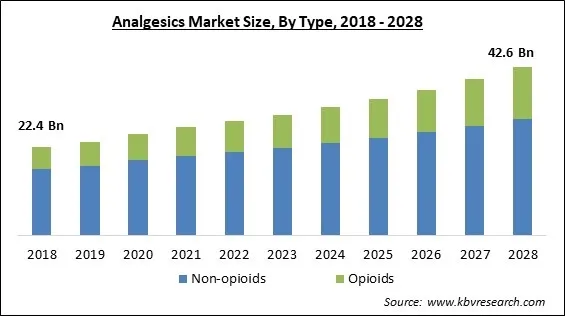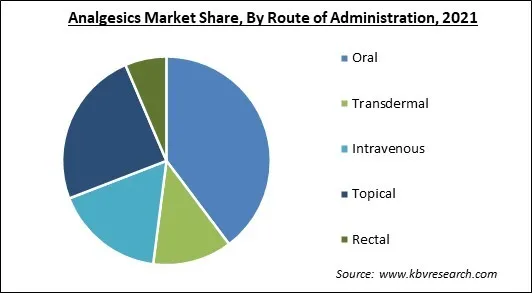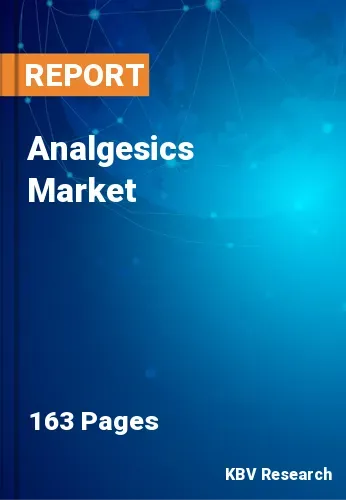The Global Analgesics Market size is expected to reach $42.6 billion by 2028, rising at a market growth of 6.6% CAGR during the forecast period.
Analgesics, or painkillers, are drugs that are used to cure and relieve pain in the body. They are utilized when the suffering is extreme and the patient can no longer take it. Opioids, non-opioids, and compound analgesics (a mix of opioids and non-opioids) are the most often used topical analgesics worldwide. The most powerful painkillers are opioid medicines, which are developed from opium. They're only available with a prescription and are usually utilized to treat moderate to severe pain. Non-opioid drugs, on the other hand, are made out of acetaminophen rather than opium. NSAIDs (non-steroidal anti-inflammatory medicines) are another class of treatments often used to relieve mild to moderate pain.
Increased rates of chronic diseases, such as tuberculosis, cardiovascular disorders, cancer, and arthritis are driving the expansion of the analgesics market. In addition, infectious disorders, such as respiratory, gastrointestinal, and neurological disorders are causing a significant increase in the number of patients. As the prevalence of these disorders rises, so does the demand for painkillers, which is predicted to drive the analgesics market share even higher. Additionally, an increase in investment from commercial and government organizations for the production of drug manufacturing segments, as well as an increase in R&D activities for the innovation of analgesic goods, has boosted the growth of the analgesics market. According to the World Health Organization, AIDS and malaria cost the lives of nearly 1.5 million people worldwide in 2020. Tuberculosis affects ten million people each year. Despite the fact that tuberculosis is a preventable and treatable infection, 1.5 million people die from it each year, making it the leading infectious killer on the planet. Analgesics, which primarily contain opioid medications, are also in high demand due to cardiovascular illnesses and cancer.
Furthermore, the analgesics market is expected to develop due to an increase in the number of clinical tests being conducted to assess the safety and efficacy of a vast variety of therapeutic medications. Furthermore, an increase in the elderly population, as well as cardiovascular disorders, cancer, and arthritis, is a crucial component driving analgesics market trends. The aging population also has more regular concerns with pain and aches, which helps the industry grow. Furthermore, technical advancements in the pharma companies to create advanced analgesic pharmaceuticals are likely to provide lucrative prospects for the analgesic market in the coming years. Furthermore, the prevalence of major manufacturing businesses that manufacture and sell analgesic pharmaceuticals, rising demand for over-the-counter drugs, and rising healthcare spending all contribute to the market's growth.

The COVID-19 pandemic had a severe impact on various economies all over the world. Numerous businesses across the world were significantly demolished by the effect of the pandemic. In addition, governments all over the world were compelled to impose lockdown in their nations in order to regulate the diffusion of the COVID-19 infection. This lockdown scenario not only devastated various industries but also disrupted the worldwide supply chain of all the products and services. However, the healthcare sector observed a significant incline in the demand for its services during the COVID-19 outbreak. There was a substantial patient pool in hospitals amid the pandemic. Moreover, a considerable number of people suffered chronic pain in their chest as a result of the side effects of the virus.
Physical pain is a prevalent problem all around the world. According to NCBI5, 20% of people all over the world suffer from some form of physical pain, with 10% of those identified with chronic pain for the first time each year. However, the issue of pain has been mostly considered as a medical problem, with public health paying little attention to it. The prevalence, frequency, and broad-ranging social and health consequences of pain mandate that the public health system pays particular attention to it. As a result, healthcare providers, as well as public health practitioners, would have an increased understanding of pain along with the most effective public health as well as social policy solutions.
A pharmaceutical substance that activates certain brain receptors is known as an agonist. These agonists induce a robust physiological/pharmacological response even when just a limited number of receptors are activated, indicating that the medicine has high intrinsic activity. Strong agonist analgesics, including opioids, like encompass fentanyl, morphine, dihydromorphinone, oxycodone, and oxymorphone. The global health system was wrought havoc by COVID-19. During the pandemic, health organizations all over the world were aimed at regulating infection and addressing COVID-19 patients, which resulted in the suspension of elective surgeries and consultations, putting a strain on hospital and pain clinic pain services.
Due to the prevalence of deaths caused by drug overdose involving opioids and other analgesics remains high, researchers and governments around various countries continue to monitor opioid overdose deaths. Opioids caused about 50,000 deaths in 2019, more than six times the number of opioid-related fatal overdoses in 1999. It's crucial to determine and identify which substances are implicated in an overdose, how often they're present, and how their presence changes over time. By recognizing drug involvement, practitioners can better identify effective prevention and response activities. Overdose death data has traditionally been analyzed using the National Vital Statistics System mortality data (NVSS-M), with the combined classifications of semi-synthetic, natural, and synthetic opioids

Based on Type, the market is segmented into Non-opioids and Opioids. In 2021, the opioids segment witnessed a substantia revenue share of the analgesics market. The rising growth of the segment is attributed to the rapidly rising instances of cardiovascular diseases. An increase in the rates of chronic diseases, such as tuberculosis, arthritis, and cancer is likely to fuel the growth of the opioid segment during the forecast period. In addition, the growth of the segment is also surging as opioids have anti-inflammatory, analgesic, and antipyretic properties.
Based on Route of Administration, the market is segmented into Oral, Transdermal, Intravenous, Topical, and Rectal. In 2021, the oral segment procured the largest revenue share of the analgesics market. The constantly increasing growth of this segment is attributed to the fact that oral analgesic delivery is simple, non-invasive, and effective in contrast to other methods of administration. Furthermore, the expansion of the oral administration segment is fueled by an increase in the number of FDA drug approvals as well as developments in pharmaceutical R&D activities across several developed nations all over the world.
| Report Attribute | Details |
|---|---|
| Market size value in 2021 | USD 27.6 Billion |
| Market size forecast in 2028 | USD 42.6 Billion |
| Base Year | 2021 |
| Historical Period | 2018 to 2020 |
| Forecast Period | 2022 to 2028 |
| Revenue Growth Rate | CAGR of 6.6% from 2022 to 2028 |
| Number of Pages | 163 |
| Number of Tables | 270 |
| Report coverage | Market Trends, Revenue Estimation and Forecast, Segmentation Analysis, Regional and Country Breakdown, Companies Strategic Developments, Company Profiling |
| Segments covered | Type, Route of Administration, Region |
| Country scope | US, Canada, Mexico, Germany, UK, France, Russia, Spain, Italy, China, Japan, India, South Korea, Singapore, Malaysia, Brazil, Argentina, UAE, Saudi Arabia, South Africa, Nigeria |
| Growth Drivers |
|
| Restraints |
|
Based on Regions, the market is segmented into North America, Europe, Asia Pacific, and Latin America, Middle East & Africa. In 2021, North America accounted for the largest revenue share of the analgesics market. The growth of the analgesics market across North America is attributed to the rise in demand for non-opioid medications, the presence of key players, and the expansion of R&D activities across the healthcare sector in the region. The increasing growth of the regional market is also owing to an increase in painkiller use, increased awareness about the utilization of analgesic drugs, increased healthcare expenditures, increased OTC analgesics market growth, and increased analgesics product adoption.
Free Valuable Insights: Global Analgesics Market size to reach USD 42.6 Billion by 2028
The market research report covers the analysis of key stake holders of the market. Key companies profiled in the report include AbbVie, Inc., Reckitt Benckiser Group PLC, Abbott Laboratories, Johnson & Johnson, Bayer AG, Endo International PLC, GlaxoSmithKline PLC, Pfizer, Inc., Sanofi S.A., and Eli Lilly And Company.
By Type
By Route of Administration
By Geography


The analgesics market size is projected to reach USD 42.6 billion by 2028.
Rising demand for strong agonists are increasing are driving the market in coming years, however, risk of overdose and addiction growth of the market.
AbbVie, Inc., Reckitt Benckiser Group PLC, Abbott Laboratories, Johnson & Johnson, Bayer AG, Endo International PLC, GlaxoSmithKline PLC, Pfizer, Inc., Sanofi S.A., and Eli Lilly And Company.
The Non-opioids segment acquired maximum revenue share in the Global Analgesics Market by Type in 2021, thereby, achieving a market value of $29.6 billion by 2028.
The North America market dominated the Global Analgesics Market by Region in 2021, and would continue to be a dominant market till 2028; thereby, achieving a market value of $15.3 billion by 2028.
Our team of dedicated experts can provide you with attractive expansion opportunities for your business.

